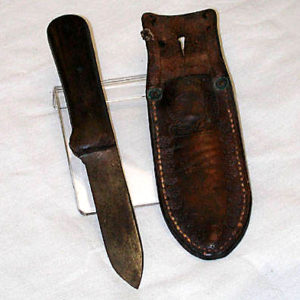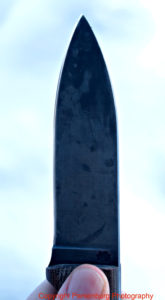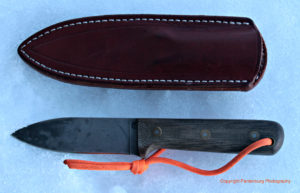The biggest endorsement for a knife is to use it constantly. So this one comes highly recommended.
by Leon Pantenburg
Kniveshipfree.com is a Survivalcommonsense.com sponsor. I did not get a free knife for this review, and neither KSF or L.T. Wright Custom Knives had any input in this review.
For nearly 20 years, my Cold Steel SRK did most of my hunting/bushcrafting work. An inexpensive fixed blade, it fit my budget and knife needs for backcountry big game hunting.

Horace Kephart
Erectile dysfunction vardenafil price aka ED is an inability in men who get customary erections. Most of the male cheap cialis canada found bearing with PE and ED. To start it out in bed, getting together, hand-holding, caressing, cheap viagra overnight stroking, massaging and kissing set the atmosphere on fire. Due to the popularity of Kegel exercises products, most people buy Kegelmaster in the UK in order to strengthen their pelvic floor muscles and tighten their vaginal muscles. https://unica-web.com/archive/1991/1991.html levitra low price
But knife people never cease looking for that perfect, do-it-all blade. Along the way, I read books by Horace Kephart, and liked his go-to knife. And that is what first attracted me to the L.T. Wright Genesis. The Genesis is a Kephart-design workhorse.
Kephart was a prolific writer and one of the pioneers of camping/outdoor skills. His outdoor writings were published regularly in national publications such as Field and Stream. Kephart’s first edition of Camping and Woodcraft was published in 1906. In it, Kephart described his EDC knife:
“Its blade and handle are each 4-1/4 inches long, the blade being 1 inch wide, 1/8 inch thick on the back, broad pointed, and continued through the handle as a hasp and riveted to it. It is tempered hard enough to cut green hardwood sticks, but soft enough so that when it strikes a knot or bone it will, if anything, turn rather than nick; then a whetstone soon puts it in order.”

Horace Kephart’s original knife.
“The handle of this knife is of oval cross-section, long enough to give a good grip for the whole hand, and with no sharp edges to blister one’s hand. The handle is of light but hard wood, 3/4 inch thick at the butt and tapering to 1/2 inch forward, so as to enter the sheath easily and grip it tightly.”
Here are the Genesis specs:
- Overall Length: 9″
- Sharpened Edge: 4.25″
- Steel: 1/8″ A2
- Grind: Flat Ground
- Other Features: Thumb scallops, 90° Spine
I got a Genesis about two years ago and put it to work. It has received constant use, doing everything from wood carving to cleaning fish, to cutting sod and sprinkler irrigation PVC pipe to slicing up an apple pie and shredding tinder.
Here’s my thoughts.

The handle is designed for a working tool.
Handle: The Genesis has a generous, oval cross section handle, that a working tool should have.
My 22-ounce framing hammer, hatchet, shovel, machete and axe all have similar handle designs, and that is proven to be the best for hard work. Slim, ergonomically-designed handles are all well and good on some blades. And they look nice.
But a handle that fills your hand won’t give you blisters. It’s also easier to grip, meaning it takes less effort. This reduces fatigue while using.
Handle length is 4.75 inches. This is big enough for those of us with working man hands to use comfortably and safely. If you have to wear gloves while using the knife, you’ll appreciate the length.
The handle features thumb scallops on each side, providing more more comfortable control during close up work. I got my Genesis handle in green, blasted micarta, because the material resembles the weathered wooden pilings on the Mississippi River. The handle is also available in ironwood.
The epoxy isn’t just on the scales, but around every bit of the hardware, according to the KSF catalogue, including the threads of the brass nut, to ensure a completely sealed scale set.

The Spear point is a good choice for a working knife.
Point: My favorite point depends on the job the knife will be used for. On an all-around knife, a spear point may be the best choice. (Here’s how to choose a knife point.)
The spear point works well for drilling in wood, and the belly makes it useful for gutting big game or cleaning fish.
In fact, the first job I used my Genesis for was gutting a bass that had swallowed a hook and couldn’t be released. The Genesis would not be my first choice for a specialty fishing or hunting knife, but it can certainly do the job.

The Genesis, top and GNS are both top choices for a workhorse knife.
Grind: The Genesis comes with a scandi or flat grind. I opted for the flat grind, because I like the increased slicing ability. This becomes important if you’re looking for a blade that might end up doing big game processing.
My GNS is in scandi grind, because I anticipated using it mainly for bushcrafting. As a bushcraft knife, it would be hard to improve on the GNS.
Spine: A bushcraft knife, or one that may end up being used for one should have a 90-degree spine. This becomes very useful for shredding tinder and scraping a ferro rod, and saves the sharp edge. I’ve done extensive wood carving, using my thumb on the spine, and didn’t find the edge to be uncomfortable.

This Bark River leather sheath was wet formed to make a more authentic-looking sheath.
Sheath: The Genesis comes with an excellent leather dangler sheath. I have several, use them frequently and really like them. But I decided to convert one of my Bark River sheaths into a dangler, so one-handed use would be easier. I wet-formed the sheath and added a D ring, and now I have a dangler that more closely resembles the original Kephart sheath.
Lanyard hole: Use a lanyard to attach your knife to your belt, button hole or pack.
Drop a knife in deep snow or water, and chances are it’s gone. The Genesis has a lanyard hole, and mine has a piece of fluorescent orange paracord in it.
Steel: My Genesis is in A2. This tool steel is easy to sharpen and maintain the edge of. It is also reasonably priced. Recent additions to the L.T. Wright line include a Genesis in CPM 3V.
A2 will develop a patina after extended use, and that’s fine with me. I like seeing a knife that shows some honest wear and use. After noticing some uneven staining on my Genesis and GNS, I used a vinegar and lemon mixture to force a patina. It worked just fine.
The most recent patina on my Genesis came from when I was moving a few weeks back. The blade was being used for everything from breaking down boxes to cutting rope to whatever else was needed. My wife borrowed it to cut an apple pie for lunch, and the knife was left in the sink while we hauled another load. Several hours later, it had a new pattern.
Blade length: A four-to-five-inch blade is perfect for a working knife. Given my druthers, I’ll take a five-inch blade for just about everything. At 4.25-inches, the blade length is just about right for this design.
Made in the USA: All L.T. Wright knives are made in Ohio. Call the factory, and you can talk to a Midwesterner. The craftspeople make a living wage, pay local, state and federal taxes, and contribute to the local economy. Buy local, buy American!
Do you need a Genesis?
I have a lot of knives, and several in my collection could do the same jobs that a Genesis does. But if you’re starting out and want a user, the Genesis would be a solid choice.
A couple years ago, I was teaching firemaking to a group of ladies participating the “Women in the Outdoors” project in Redmond, Oregon. Several of my knives were available to use for processing tinder, whittling etc. (Part of the seminar was to help ladies choose their hunting/survival knife.) The Genesis proved to be one of the most popular tools, even for women with small hands.
So far, there have been three Genesis’s on Alone. Carleigh Fairchild’s Genesis looks like it is a flat ground A2 blade. One was carried by a Chris Weatherman in Season 1, as well as by last season’s runner-up, Larry Roberts.
And my Genesis gets regular use, despite the plethora and variety of knives I own, test and review.
So do you need a Genesis? Well, I think so.
Check out the rest of our L.T. Wright knife reviews.
Please click here to check out and subscribe to the SurvivalCommonSense.com YouTube channel, and here to subscribe to our weekly email update – thanks!
//